Get a Free WorkTrek Demo
Let's show you how WorkTrek can help you optimize your maintenance operation.
Try for freeWhy is facilities management critical in healthcare environments? Healthcare facilities must maintain high patient care, safety, and operational continuity standards. Facilities managers are indispensable in navigating complex regulations, managing life-sustaining systems, and preparing for tomorrow’s healthcare challenges. This article explores how effective facilities management in healthcare can be a decisive factor in delivering exceptional medical services.
Healthcare facility managers do everything: infrastructure, safety and compliance, facility and medical equipment, disease spread, patient care with the latest technology, strategic planning and future-proofing, optimizing resources, reducing costs, and improving service delivery.
Scope of Facilities Management in Healthcare
Healthcare facilities management is the critical backbone of healthcare, ensuring that healthcare institutions are well-maintained, operational, and secure. Facilities managers oversee everything from routine maintenance to coordinating extensive construction projects in pursuit of seamless healthcare service delivery.
This goes beyond simply overseeing daily tasks; it is dedicated to creating and fostering an environment where exceptional care is delivered safely and securely for patients and healthcare professionals alike.
Achieving this involves a meticulous Environment of Care strategies and rigorous compliance with regulatory requirements and safety protocols.
The Core Responsibilities of Facility Managers

Source: Health Facility Management Magazine
Professionals managing facilities within the healthcare sector play an array of vital roles. Their responsibilities include:
- Guaranteeing adherence to legislation like the Americans with Disabilities Act
- Maintaining ongoing certifications and accreditations
- Safeguarding the well-being of practitioners in the healthcare setting
Another essential duty they perform is maintaining the physical infrastructure of their facilities. Whether it’s confirming that lighting systems are operational or assuring peak performance of HVAC systems, these managers play a pivotal role in facilitating smooth healthcare operations.
The Impact on Patient and Provider Safety
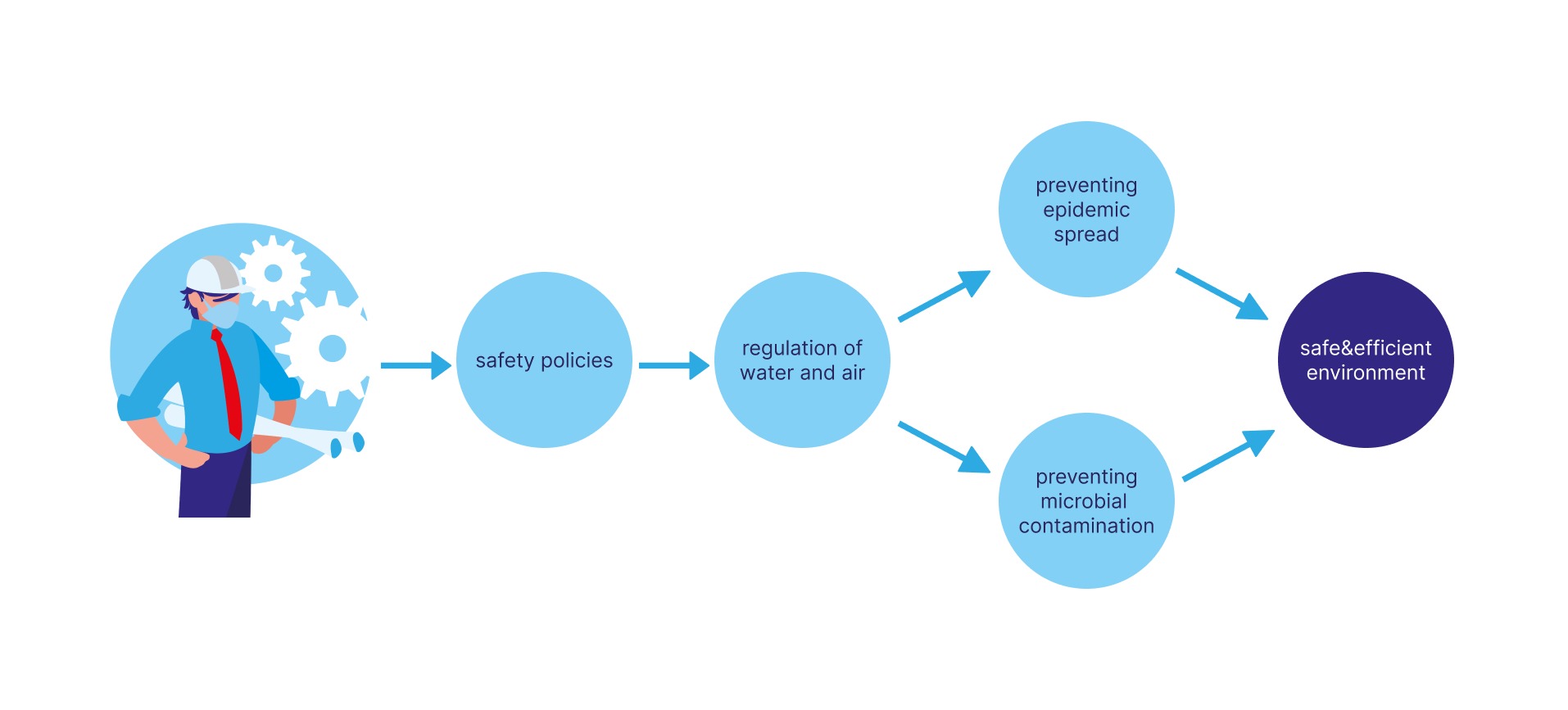
Source: WorkTrek
Safety is paramount in the healthcare sector. Facility management is crucial in establishing thorough safety policies that harmonize procedures throughout various healthcare settings. This management ensures that patients and staff are provided with an environment that’s secure but also efficient and enduring, paying particular attention to the regulation of air and water.
Consistent assessments and effective plant operations are key to diminishing risks associated with healthcare while guaranteeing an exemplary care environment. When considering the critical aspect of infection control, it becomes clear how instrumental facility management is in forestalling epidemic spread and managing microbial contamination within these institutions.
Role of Healthcare Facility Managers
Managers of healthcare facilities shoulder a wide array of responsibilities that encompass:
- Promoting the well-being and safety of both patients and staff
- Upkeeping the physical integrity of the facility
- Inhibiting transmission of illnesses
- Upholding adherence to regulatory standards as well as ensuring security within medical settings
More than just ticking off compliance checkboxes or maintaining the status quo, effective management shapes patient and visitor perceptions of their experience. It influences their sense of safety, comfort, and the overall cleanliness they notice around them. Facility managers emerge as essential players whose focus on critical aspects can significantly improve healthcare service delivery, including:
- Sustaining high-quality indoor air conditions
- Guaranteeing efficient functionality in heating, ventilation, and air conditioning systems
- Overseeing thorough sanitation practices
- Regularly checking on equipment functioning properly alongside up-to-date technologies
- Managing facilities management team
- Creating a safe and efficient environment for employees
- Establishing safety policies
- Establishing procedures for safeguarding individuals’ welfare, including emergency response protocols
In their roles at healthcare institutions, facility managers are committed to shaping environments that promote comfort and assurance, enhancing the experience for everyone who walks through the doors.
Compliance Mastery: Certifications and Regulations

Source: CleanLink
Meeting compliance regulations is an essential obligation for healthcare facilities. Healthcare institutions engaged with federal initiatives must implement a compliance program that upholds care quality and affirms their dedication to corporate integrity.
The pivotal role of facility managers in fulfilling these requirements cannot be overstated. Their expertise is fundamental in ensuring that healthcare facilities meet and exceed the standards set forth by various regulatory bodies.
This includes a deep understanding of complex healthcare laws and regulations and staying abreast of any changes or updates to these standards. Facility managers are the linchpins in a healthcare facility’s ability to provide patients safe, compliant, and efficient care.
They are tasked with many responsibilities that directly impact the quality of the healthcare environment, from managing budgets and staff to overseeing the maintenance of critical life-saving equipment. Their role in the healthcare sector is paramount, as they ensure that the facilities are not just places for treatment but also sanctuaries of healing that adhere to the highest standards of care and safety.
Responsible for conducting evaluations related to various aspects such as:
- Ensuring life safety
- Fire safety measures
- The integrity of medical gas systems
- Adequate refrigeration facilities
- Functionality of HVAC systems
- Overall security protocols within the building
- Maintaining Security
- Handle routine maintenance
Facility managers must meet established regulatory criteria, obtain certifications from recognized agencies like The Joint Commission, and adhere strictly to statutes, including the Americans with Disabilities Act.
Healthcare facility managers must manage the complexity of keeping up with evolving federal regulations and maintaining certification compliance.
Security Protocols and Data Protection

Source: TATEEDA
With the advancement of technology, cybersecurity has emerged as a significant aspect of facilities management. With the expansion of technological applications and cloud services in healthcare, facility managers must stay vigilant against potential cyber threats.
The healthcare industry faces increased cybersecurity needs from both internal and external sources. From ransomware to password attacks, organizations are under constant attack.
In addition to cybersecurity, facility managers oversee real-time security and surveillance systems to safeguard the healthcare environment. They collaborate with IT departments to secure both the medical equipment and the sensitive patient information managed within the facilities.
They must also adhere to HIPPA rules that guide the confidentiality of patient records and electronic medical records.
Advancements in Technology Improving Facilities Management
Technological innovations have revolutionized healthcare facility management. The integration of advanced management systems has streamlined the organization of electronic health records and enhanced the efficiency of overall facility operations.
Preventive maintenance plans, endorsed by the Centers for Medicare & Medicaid Services (CMS), are designed to reduce service calls, prolong the lifespan of assets, and maintain optimal equipment performance.
Combining professional patient care knowledge with cutting-edge technologies like RFID tracking delivers multiple advantages. This integration not only curbs disease transmission but also improves adherence to regulations and security measures – all contributing to an enhanced patient experience within these healthcare services environments.
Tech-Enabled Maintenance Programs
The management of healthcare facilities is being transformed by the integration of technology into maintenance programs. These advanced programs are designed to accomplish several objectives, including:
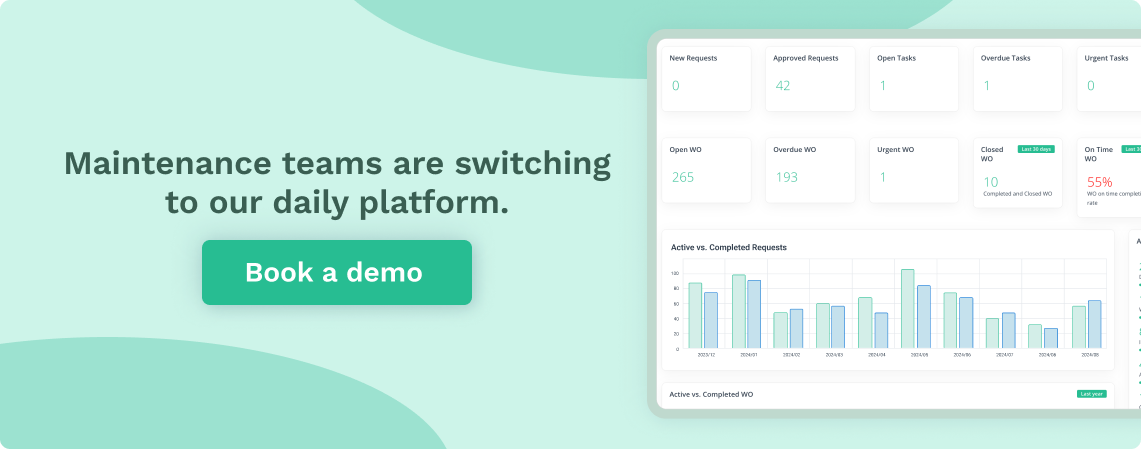
- Proactively preventing problems
- Decreasing the number of service calls
- Prolonging the life expectancy of assets
- Promoting efficient functioning of equipment
- Improving facility upkeep
- Empowering facilities managers with the latest tools
- Improving the lifespan of healthcare assets
- Improving building compliance
- Automating activities performed by the facilities management department
With systems like TeamDOC in place, automating preventive maintenance becomes streamlined as it meticulously logs and monitors every check-up.
Facility managers tailor the schedule for routine checks based on risk evaluations to confirm that facilities and medical machinery receive appropriate attention.
Regular maintenance is key to preventing significant issues, ensuring the steady operation of healthcare machines, and ensuring the dependability of emergency response systems.
Leveraging current technologies has become standard practice within facilities management for coordinating maintenance timetables across all equipment types, optimizing computer performance regularly, and safeguarding access control within healthcare institutions.
Innovations in Patient Room Comfort and Safety
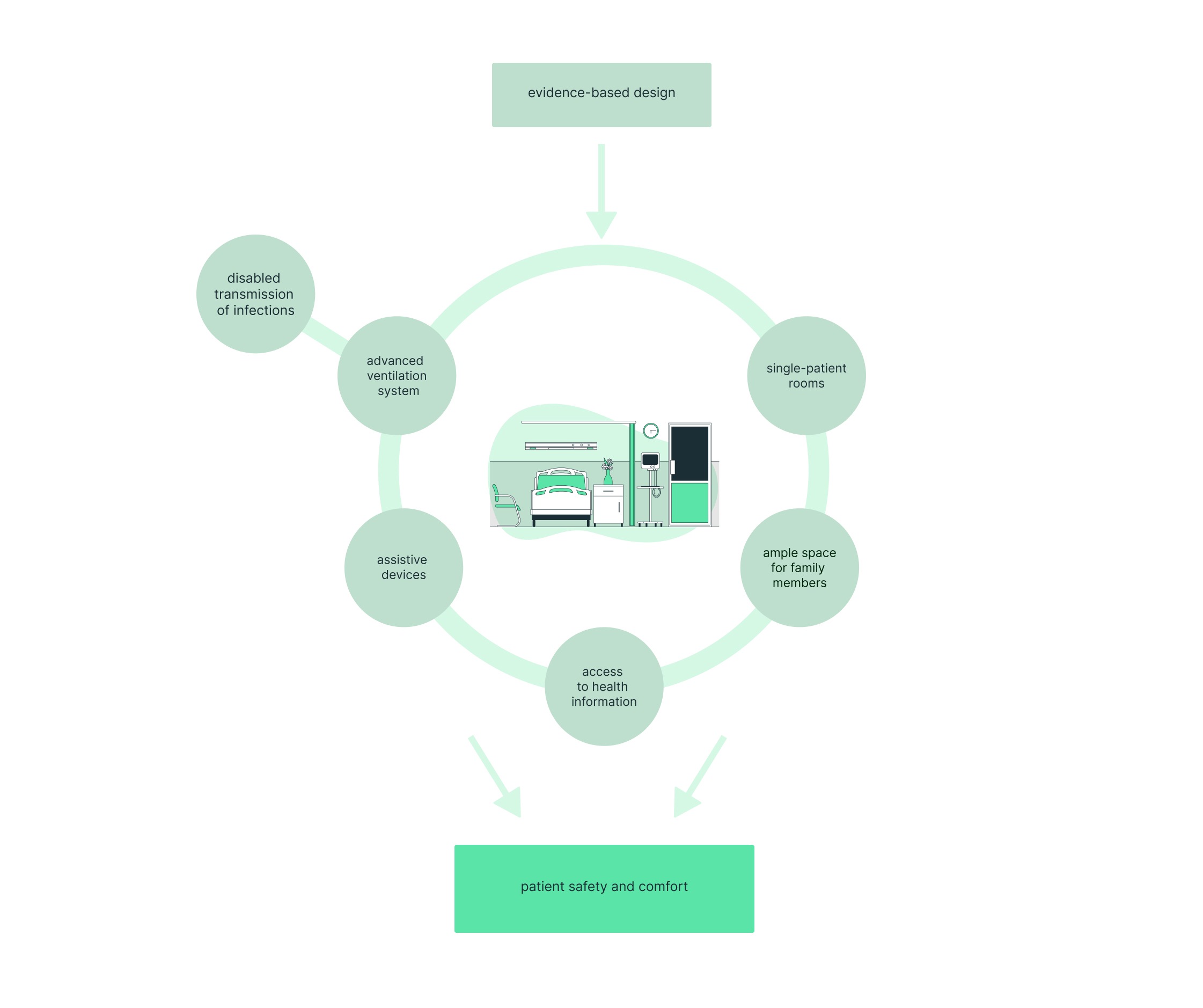
Source: WorkTrek
Recent advancements in the architecture of patient rooms significantly improve patient safety and the level of comfort they experience. Some examples include:
- Single-patient rooms for heightened infection control and privacy
- Key room elements that provide ample space for family members enable access to health information and incorporate assistive devices aimed at preventing falls
- Advanced ventilation systems designed to limit the transmission of infections
Adopting evidence-based designs in these facilities contributes to improved patient outcomes. Emphasizing flexible acuity-adaptable rooms accommodates patients’ evolving needs—this adaptability is essential in reducing incidents such as medication errors and falls.
Implementing innovative designs that consider human factors and underlying conditions can curtail cognitive mistakes and adverse events, significantly enhancing overall safety within a healthcare facility.
Challenges and Solutions in Healthcare Facility Management
There are several challenges associated with healthcare facilities management. Some of these challenges include:
- Finding qualified personnel, especially in housekeeping roles, due to the technical proficiency and patient interaction requirements
- Dealing with operational costs and budget constraints
- Ensuring proper maintenance of assets and equipment
- Implementing energy efficiency measures
- Ensuring physical security and safety of the facility and medical equipment
- Managing supply chain and inventory
- Ensuring that employees have access to properly maintained equipment
These challenges require effective management strategies and solutions to ensure smooth operations in healthcare facilities.
Yet, with challenges come opportunities for innovation and progress. Facility managers have the potential to harness their purchasing power and analyze utility consumption to uncover cost-saving opportunities.
By implementing safety measures and strategic foresight, facility managers can leverage technological advancements and adapt to demographic trends, assuring a robust supply chain and efficient operations.
Resource Optimization and Cost Savings
Management’s primary objectives within facilities include streamlining resource use and reducing costs. To this end, managers at these facilities diligently develop and manage operational budgets while also engaging in negotiations for service agreements with vendors to enhance resource efficiency.
Hospitals leverage bed-tracking systems that furnish immediate operational insights to augment revenue streams and amplify patient contentment.
Adopting a lean methodology focused on continuous improvement within these establishments can precipitate a substantial decrease in process wastefulness, thereby fostering an improved allocation of resources.
The importance of strategic planning regarding funding, workforce deployment, and space availability cannot be overstated. Patient demographics and overarching organizational aspirations also present demands.
Monitoring of consumption trends alongside advanced benchmarking methodologies allows facility managers to refine utility budget strategies, leading to pinpointed enhancements for cost reduction initiatives.
Maintaining a Clean and Welcoming Environment

Source: BestDoc
Maintaining a clean and inviting environment is essential in managing healthcare facilities. This aspect dramatically influences patient contentment levels.
A facility that prides itself on cleanliness and maintenance establishes a secure setting for patients and employees and improves the general experience within healthcare.
To uphold sanitary conditions, strategies such as stringent hygiene policies are implemented alongside routine, comprehensive cleaning practices and surveillance to ensure standards are met.
Facility managers collaborate closely with custodial staff by equipping them with adequate training and supplies necessary to preserve superior standards of cleanliness. The facility’s state mirrors its dedication to safeguarding patient well-being and providing high-quality care.
Navigating Facilities Management in Specialized Settings

Source: Healthcare Management Degree Guide
Facilities management within healthcare encompasses a multitude of tasks, including:
- Sanitation
- Upkeep
- Technological oversight
- Adherence to regulations
Distinct environments, such as surgical centers and ambulatory care institutions, necessitate bespoke facilities management strategies that cater to their specific demands.
In specialized healthcare domains, conventional segmented approaches to facilities management have been shown inadequate for overarching planning and economization. Proactively training employees in occupational safety and ensuring a safe working atmosphere is critical.
Surgical Center Specifics
The management of facilities within healthcare, particularly in surgical centers, necessitates specialized attention to accommodate intricate medical operations traditionally performed exclusively in hospitals.
Facility managers at these healthcare venues must guarantee that the premises are thoroughly sanitized, well-kept, and furnished with essential medical apparatus.
Employing integrated facilities management strategies in the realm of healthcare facilities management has proven beneficial by:
- Reducing expenses
- Enhancing compliance with regulatory standards
- Boosting energy conservation
- Managing the introduction of cutting-edge technologies and projects
- Steering modifications and augmentations of existing buildings according to service requirements
These contemporary models demonstrate greater efficiency than outdated individual campus-based management approaches for facility oversight within healthcare settings.
Ambulatory Care Adaptations
Ambulatory care centers face unique challenges that are met with innovative solutions. These centers incorporate lean design principles and process standardization to enhance patient satisfaction and streamline operations. They utilize modular and scalable design prototypes to optimize the use of space, which in turn improves operational effectiveness.
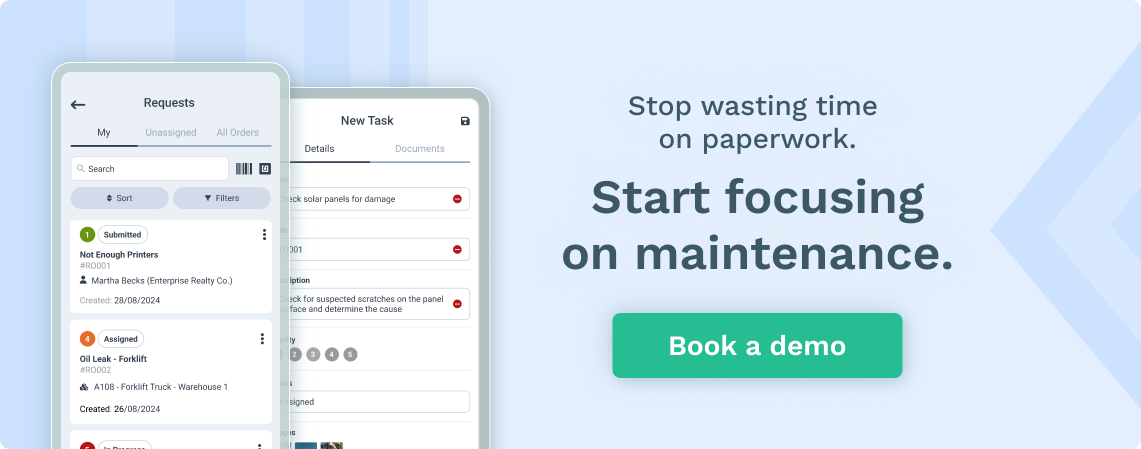
To enhance their efficiency levels, Ambulatory care centers undertake several measures.
- They thoughtfully craft spaces to clearly distinguish staff-only areas from pathways used by patients
- Innovative design features such as barn-style doors and dual-access walls for supplies are implemented to direct the flow of patients and staff effectively
- Clinical spaces within these healthcare environments are standardized across different locations, ensuring medical professionals can work seamlessly anywhere while preserving high service quality.
Establishing centralized registration hubs in these environments is important in minimizing patient wait times and streamlining the admission process, making it more efficient.
Strategic Planning for Future-Proof Healthcare Facilities
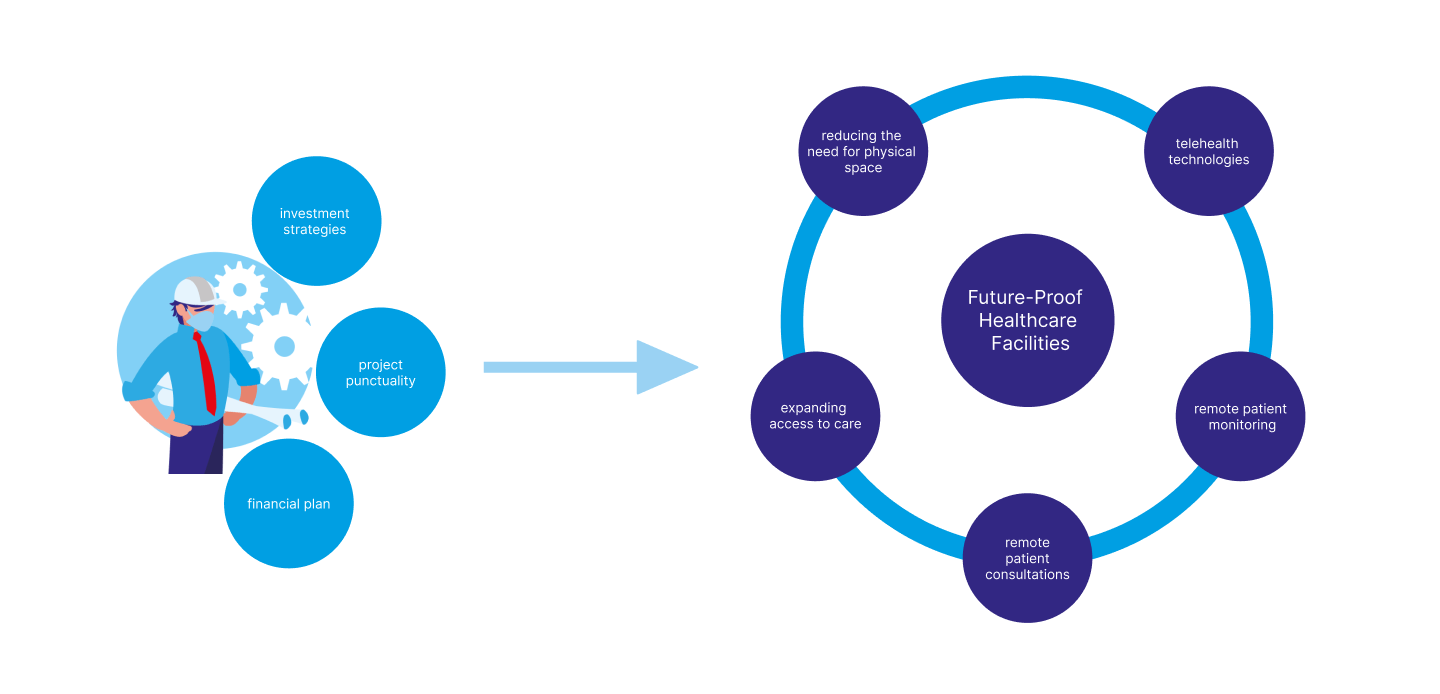
Source: WorkTrek
As healthcare organizations look to the horizon, strategic planning becomes critical in aligning with long-term objectives and proactively adapting to evolving healthcare needs.
Managers of these facilities are responsible for guiding capital investment strategies and guaranteeing that projects within the facility conclude punctually and within financial constraints.
Substantial digital transformations in how services are organized and dispensed are imperative to preserve hospitals’ sustainability well into the future. These transformations include adopting telehealth technologies, allowing for remote patient monitoring and consultations, expanding access to care, and reducing the need for physical space.
Electronic health records and digital data management systems streamline workflows and improve communication among healthcare professionals, enhancing patient care. Integrating artificial intelligence and machine learning can also lead to more accurate diagnostics and personalized treatment plans.
As healthcare continues to evolve, embracing these digital advancements will be key to staying ahead in an increasingly competitive and technology-driven world.
Building for Tomorrow
Within healthcare facilities management, crafting a strategy is fundamentally about future-proofing. Those managing facility operations undertake forward-thinking planning for either new builds or refurbishments to meet upcoming demands in healthcare provision while also maintaining environmental sustainability.
State-of-the-art visualization technologies, including virtual reality (VR) mock-ups, are being utilized to perfect functional space configurations by integrating user feedback into early design stages.
Novel digital tools designed for site logistics are emerging that enhance collaboration among construction teams by providing real-time updates on delivery timelines and onsite requirements.
Embracing Sustainability in Health Systems

Source: Medic Academy
A key component of preparing healthcare facilities for the future involves incorporating sustainability into health systems.
Through careful planning, a facility aligns its resources with its objectives, integrating sustainability efforts that reflect the organization’s commitment to enhancing community health.
Introducing sustainable measures within healthcare operations brings various advantages, including cost reductions, enhanced patient care, and increased staff engagement.
Summary
Healthcare facilities management is a multifaceted and critical area supporting the seamless provision of medical services. Managers of these facilities navigate a broad range of duties, from ensuring regulatory adherence to embracing technological breakthroughs. Working quietly in the background, these managers are committed to the continuous functioning of healthcare settings, promoting the health and safety of everyone who enters the facility.
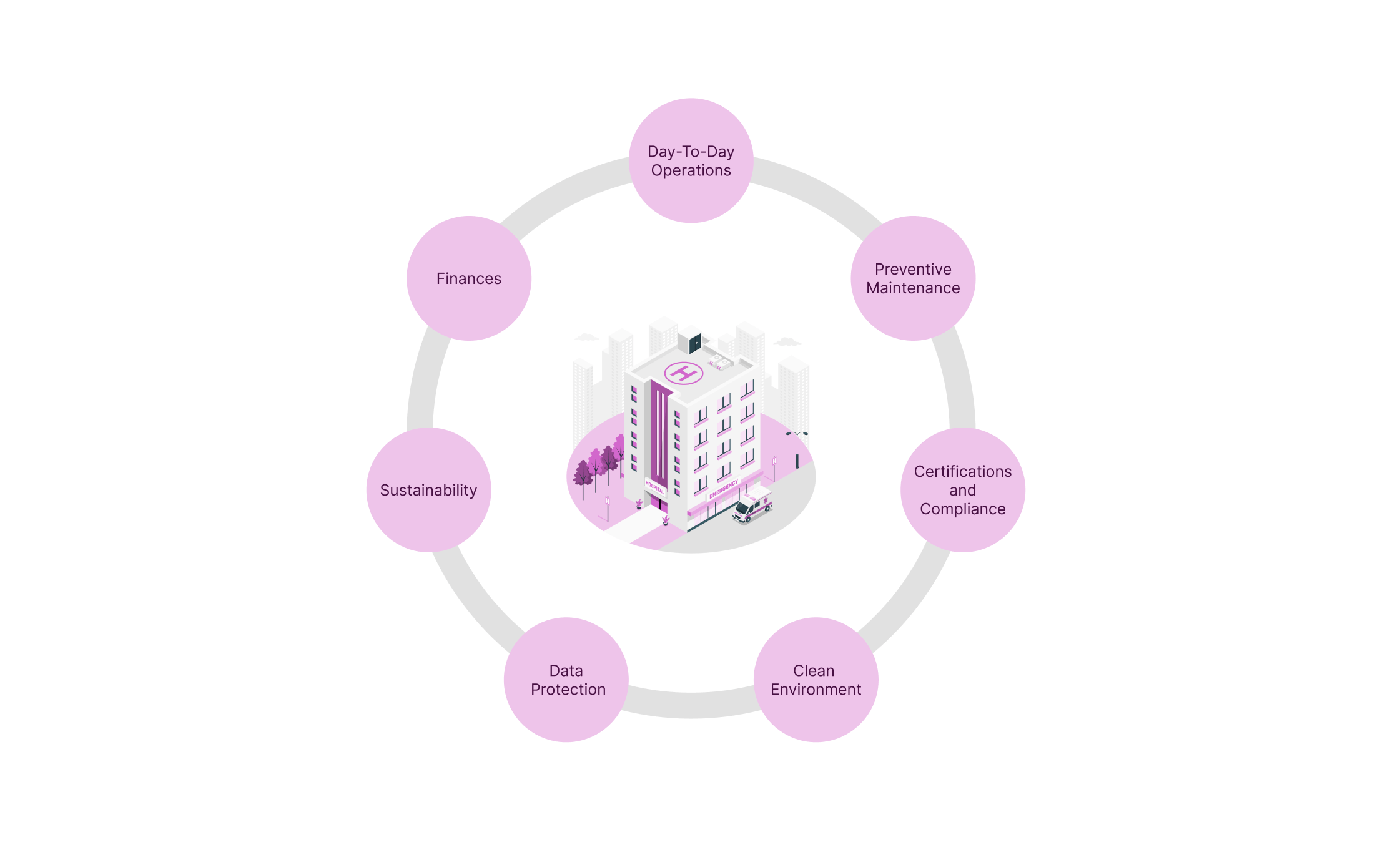
Source: WorkTrek
Frequently Asked Questions
What is healthcare facilities management?
Healthcare facilities management involves overseeing facilities’ development, operations, security, and regulatory compliance to ensure a safe and efficient environment for healthcare delivery.
What are the core responsibilities of healthcare facility managers?
Healthcare facility managers hold the essential duty of maintaining compliance with regulations and certifications, safeguarding provider safety, and overseeing the upkeep of the healthcare facility.
How does technology enhance facilities management?
Technology plays a pivotal role in enhancing the management of healthcare facilities by deploying plans for routine maintenance, programs for managing energy consumption, and systems for RFID asset tracking. These innovations improve operational efficiencies and reduce the costs of running these complex environments.
What are some of the challenges in healthcare facility management?
Focusing on effectively optimizing resources, achieving cost savings, and upholding a sanitary environment is crucial in managing a healthcare facility. These elements are essential for the smooth functioning of the facility and ensuring high-quality patient care within the healthcare realm.
How does strategic planning future-proof healthcare facilities?
Strategic planning centers on long-term requirements and incorporates sustainable practices, ensuring healthcare facilities are prepared for the future within health systems.










